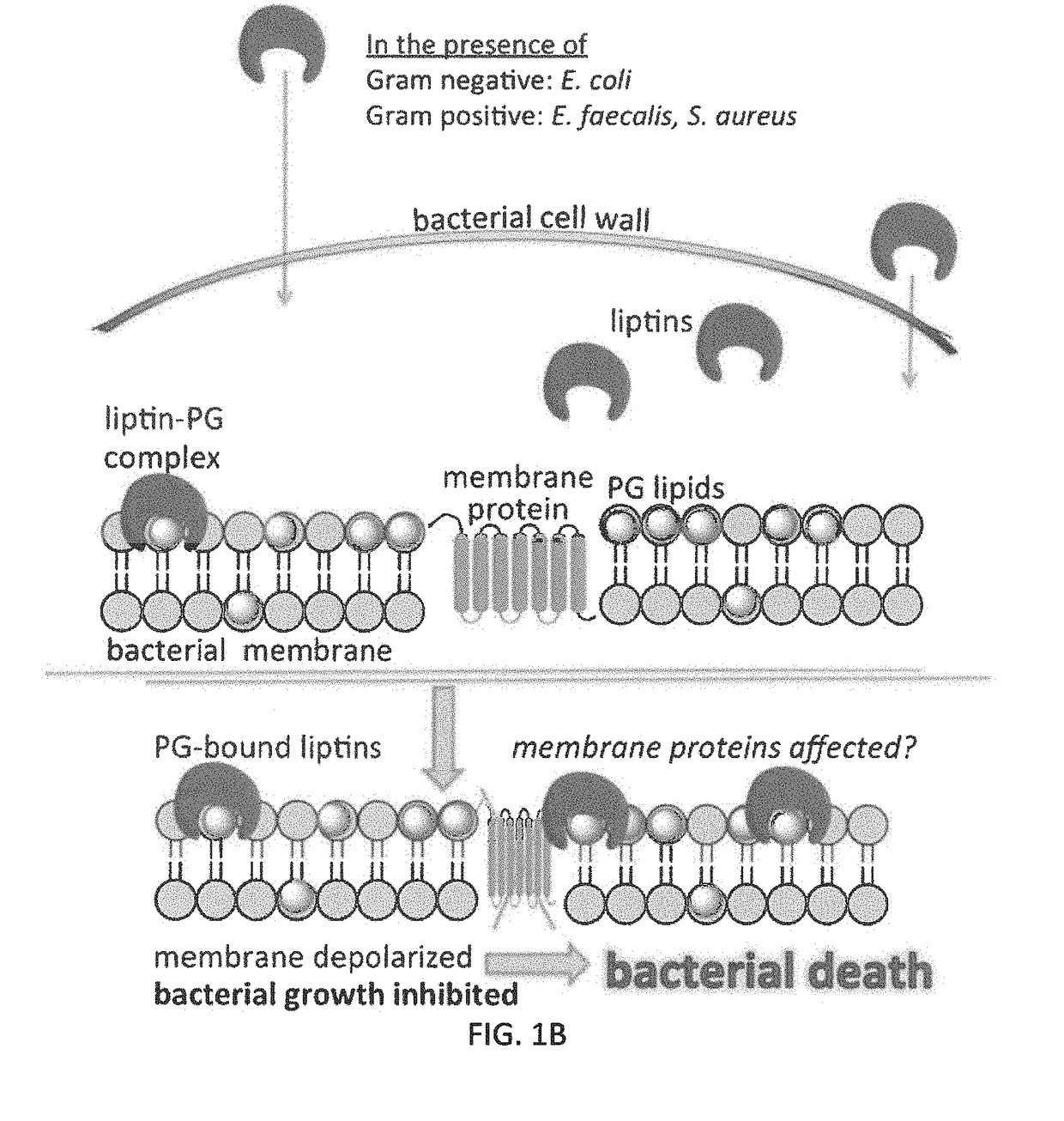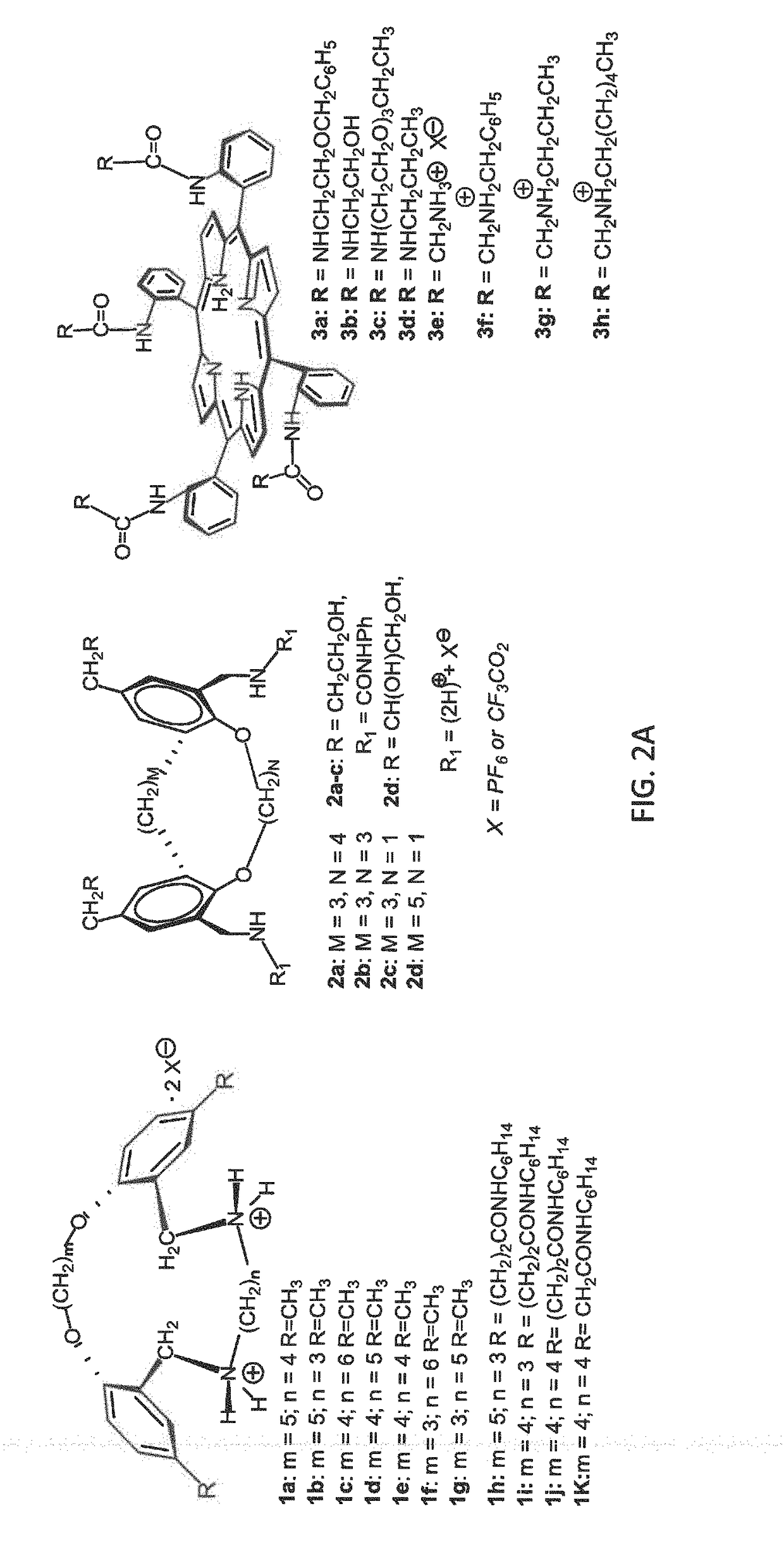Compounds for inhibiting bacterial growth via phosphatidylglycerol binding
a technology of phosphatidylglycerol and bacterial growth, which is applied in the direction of antibacterial agents, biocide, organic chemistry, etc., can solve the problems of lowering cell viability, altering physical chemistry, and disrupting the homeostasis of the lipidome, so as to improve the basic understanding of heterogeneous membrane function
- Summary
- Abstract
- Description
- Claims
- Application Information
AI Technical Summary
Benefits of technology
Problems solved by technology
Method used
Image
Examples
example 1
[0100]In a project designed to develop targeting systems for bacterial membranes, we have generated novel families of small molecules (termed liptins) that are the first to show good complementarity with the PG head group (Koralegedara et al., J. Org. Chem. 2011, 76, 1930-1933; Alliband et al., J. Org. Chem. 2013, 78, 356-362; Alliband et al., Org. Biomol. Chem. 2015, 13, 502-512). Specifically, we have synthesized liptin's binding pocket with suitably spaced functionality to bind and correctly align with two different sets of lipid functional groups, the phosphate anion portion and the neutral glycerol hydroxyl groups. We demonstrated that the four pickets on meso-phenyl rings of a porphyrin scaffold, or the ortho-para substituents on two types of linked bis-phenol scaffolds, when appropriately functionalized, formed a complementary binding pocket to the PG lipid's multifunctional head group. Thus, the liptins are the first target-based designed small molecules capable of tight bin...
example 2
[0110](2.1) Determination of Liptin-PG Binding in Solution. The lipid binding ability of liptins 1-3 (FIG. 2A) have been investigated in solution using isothermal titration calorimetry (ITC) and / or 1H NMR. Stoichiometry of binding was accomplished with Job plots using 1H NMR. Table 1 details liptin-PG association constants, and ITC data shows both the enthalpy and entropy associated with binding, for the TBA phosphatidylglycerol anion with a 1:1 stoichiometry of binding. The use of organic solvents allowed the determination of binding motif using 1H NMR. Spectroscopic studies showed that liptins with the preorganized (ortho-ring substituted) ammonium or urea groups found in compounds 1 or 2, or the four ammonium or urea pickets on the porphyrin ring as in 3, bound to the PG lipid's phosphate anion group via hydrogen bonds. Additionally, published spectroscopic data showed that the PG's glycerol hydroxyl group hydrogen-bonded with 3e's amide group, while unpublished data showed PG's ...
example 3
[0125](3.1) Bacterial Experiments: Determination of Minimum Inhibitory Concentration (MIC).
[0126]The uptake of phosphatidylglycerol liptin 3e by E. coli (Gram-negative bacillus), or Staphylococcus aureus or Enterococcus faecalis (both Gram-positive cocci) inhibits bacterial growth. We have reported that the 3e is able to penetrate both Gram-negative and Gram-positive bacterial walls and reach the plasma membrane. FIG. 10B shows the absorbance (420 nm) values of supernatants of various trials from cell lysis experiments with E. coli and Bacillus thuringiensis after incubating the bacterial solutions with liptin (10 or 25 μM) for 1 h. This previous work demonstrates that the liptin (previously referred to as a “receptor”) binds to bacterial membrane components.
[0127]Here, we have determined the MIC of liptin 3e to be less than 2 μM. We assessed the MIC for E. coli and growth only in seen in control and 1 μM tubes, establishing an MIC between 1-2 μM. We also assessed the MIC for Staph ...
PUM
| Property | Measurement | Unit |
|---|---|---|
| length | aaaaa | aaaaa |
| length | aaaaa | aaaaa |
| binding constant | aaaaa | aaaaa |
Abstract
Description
Claims
Application Information
 Login to View More
Login to View More - R&D
- Intellectual Property
- Life Sciences
- Materials
- Tech Scout
- Unparalleled Data Quality
- Higher Quality Content
- 60% Fewer Hallucinations
Browse by: Latest US Patents, China's latest patents, Technical Efficacy Thesaurus, Application Domain, Technology Topic, Popular Technical Reports.
© 2025 PatSnap. All rights reserved.Legal|Privacy policy|Modern Slavery Act Transparency Statement|Sitemap|About US| Contact US: help@patsnap.com



